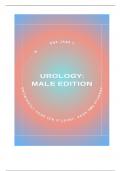,Male reprodcutive system: histology, anatomy and pathology
Histology, anatomy & physiology
TESTES
Surrounded by thick capsule = tunica albuginea , which thickens at the posterior side to form
the mediastinum testi
Sertoli cells in seminiferous tubules: large cells with a lot of cytoplasm, columnar cells with
elongated nucleus
o Abundant SER
o Columnar type of epithelium
o Tight junctions (blood-testis barrier) + gap junctions
o Functions:
Support, protection and nutrition of spermatogenic cells, which cant get
nutrient from bv in connective tissue bc under blood-testis barrier; supplies
plasma factors for cell growth and differentiation
FSH: stimulates release of androgen-binding protein from sertoli cells to
accumulate testosterone ; releases inhibin to negatively feedback FSH
Phagocytosis of residual bodies of sperm
Septa divide the testes into testicular lobules with ech 1-4 seminiferous tubules (with
stratified germinal/spermatogenic epithelium, with myoid smooth muscle cells onder BM) --
> to intratesticular ducts:
o straight tubule (which only has Sertoli cells) --> rete testi in mediastinum (cuboidal
epithelium surrounded by thick connective tissue with bloodvessels of mediastinum)
--> efferent ductules (cuboidal epithelium with microvilli to absorb fluids from sertoli
cells + cilliated cells: both act to passivley move sperm, also layer of smooth musscle
cells to move sperm into epididimys
As they descend, they take their serous layer with them: tunica vaginalis, which has a
visceral layer on tunic albuginea and a parietal layer under the scrotum
Scrotum: maintain 34 degrees of testes to allow spermatogenesis by:
o Pamipform venous plexus around testicular artery takes heat from artery =
countercurrent heat exchange system
o Scrotum sweat evaporation
o By control of muscle can move testes near or away from legs
Excretory genital ducts:
Epididymis: Head (from efferent ductule), body (modifies sperm further) and tail (Storage
sperm)
, Pseudostratified columnar epithelium with stereocilia = principal cells which remove
water and residual bodies and secrete: protein, glycoprotein, vesicles with lipids etc.
Sperm stays 2-4wks in here until to vas deferens
Sperm gains ability to move, final modifying of acrosome, reorganize cell membrane
around sperm head --> cholestrol to block acrosomal activation
Smooth muscle cells, and longitudinal inner and outer muscle in tail to move sperm
to vas deferens
Vas deferens: very thick outer muscular wall (inner and outer smooth muscle + circular
muscle in between), narrow folded mucosa lumen, strong peristalsis
Pseudostratified epithelium with some cilia
Spermatic cord: vas deferens, testicular artery, pampiform venous plexus, deferens ductus
artery, cremastor artery, genital branch of genitofemoral nerve, autonomic nerves
Layers spermatic cord & from above tunica vaginalis parietalis:
o Internal Spermatic fascia: derived from fascia transversalis
o Middle spermatic/ cremastor fascia: derived from internal abdominal
oblique
o External spermatic fascia: derived from aponeurosis of external abdominal
oblique
Then Dartos fascia --> scrotal skin
Accessory glands:
Seminal vesicles:
Citric acid, fructose + other nutrients
Unusual mucosa: numerous thin folds that fill most of lumen
Pseudostratified columnar epithelium
Circular inner and outer longitudinal smooth muscle
Fibrinogen, prostaglandin (enhances fertility by: 1) reacts with mucoid cervix to
make it more receptive to sperm motility 2) stimulates backward perisaltic
contractions of uterus and fallopian tube to migrae sperm to ovum)
Prostate gland:
Ca, citrate, phosphate ion,s clotting enzyme, profibrinolysin
Pseudostratified and simple columnar epithelium, tubuloacinar glands
Right below bladder
Corpora amylacea: some lobes contain small round concretions with glycoprotein
and keratan
Surrounded by fibroelastic capsule with septa that divide gland in lobes
3 zones around prostatic urethra:
o 1. peripheral zone: contains 70% of total tissue, with main glands
o 2. central zone: contain 25% of tissue, with periurethral submucosal glands
o 3. transitional zone: 5% of total tissue with periurethral mucosal glands
Semen clots by clotting enzyme to cervix which turns finrinogen into fibrin, then
dissolved by fibrinolysis
Cowper's glands = bulbourethral glands + Uretrhal internal glands:
produce mucus for lubrication (under PNS) during sexual activity
Simple columnar epithelium tubuloacinar;
Location: in urogenital diaphragm, empties in proximal penile erethra
PENIS:





